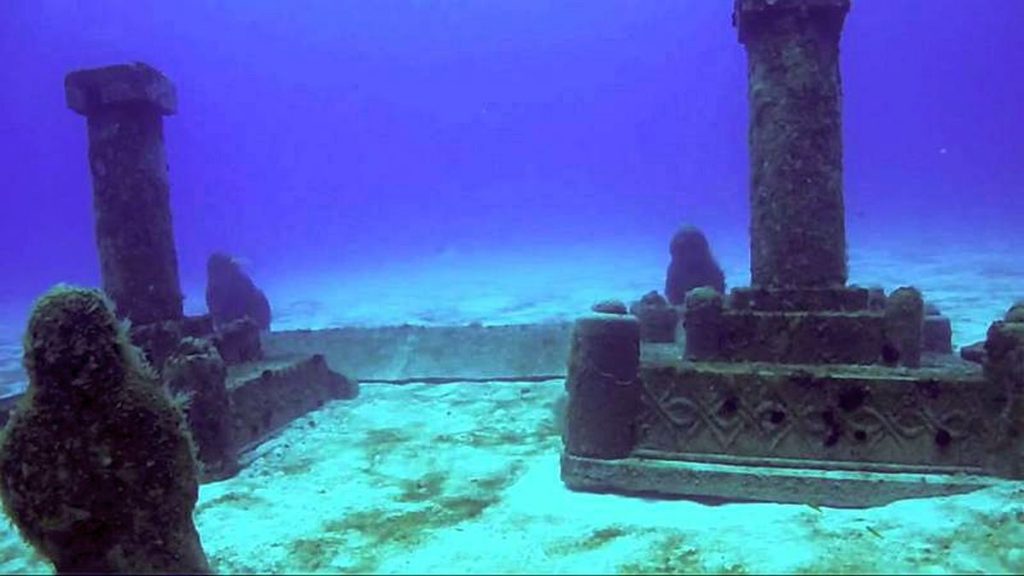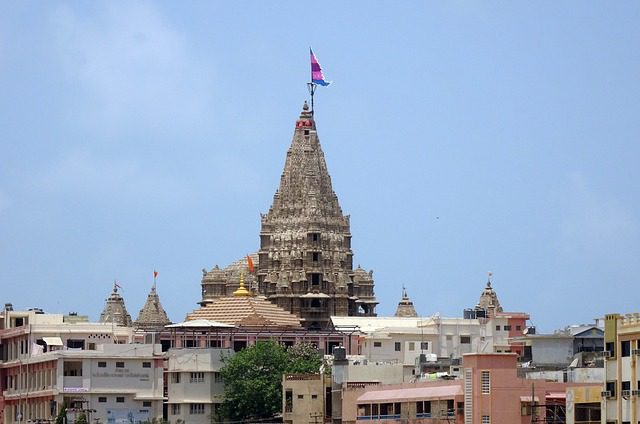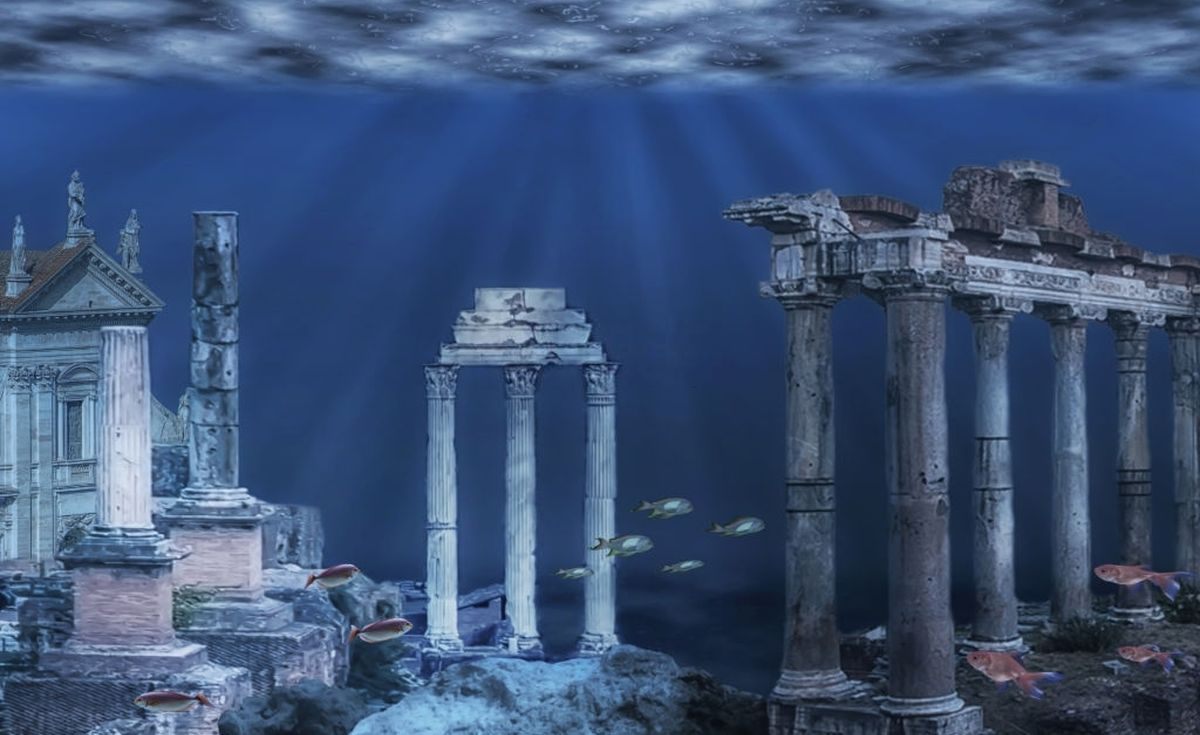The ancient Indian city of Dwarka is known in Hindu culture to have been the great and beautiful city of Krishna. The Hindu writings say that when Krishna left the Earth to join the spiritual world, the age of Kali (Kaliyug) began and Dwarka and its residents were submerged by the sea.
The modern Dwarka is one of the seven sacred towns of Hinduism, visited each year by pilgrims worshiping Krishna. But this is not the Dwarka we are talking about, Dvaraka or Dvāravatī is the mysterious submerged ancient city of Lord Krishna that has captured the imagination of Indians and Hindus across the world.
It is very much established and documented that marine archeological exploration of the site has revealed numerous artifacts and evidence of a port city.
But the real challenge lies with the claim that the discovery of the legendary city of Dvaraka which is said to have been founded by Lord Krishna, is an important landmark in the validation of the historical relevance of Mahabharat and Lord Krishna. Lately this has become a narrative to prove mythology through scientifice methods and archeology.
There are thousands of websites and YouTube videos claiming that the ancient city of Dwarka (We will stick to the simpler name) is the proof that Indian mythological account is indeed true.
If you were to believe some of the claims — they provide dates up-to 12000 BCE for the submerged city. So what old is the ancient Dwarka, has its discovery and archeological findings established the evidence of historical Lord Krishna and the Mahabharata War?
A word of caution here, this article is not meant to challenge your faith. I request you to only stay if you are looking for fact and evidence-based analysis of the historical Krishna’s city and its validity.
Now that you have been forewarned, let me give you a little bit of a shock. The pictures that you may have come across (most commonly used) of undersea exploration of Dwarka and what has also been circulated by even some of the big Indian media groups like India Today are fake. These were claimed to be the images of underwater Cleopatra palace, Alexandria Egypt.
The image in question can be found below:

Now the other claimed source:

The original tweet can be found here. This tweet is from the year 2014 but the sea exploration and marine archeological efforts happened in 2010. But that’s not all, even this picture of underwater Cleopatra palace, Alexandria Egypt is fake.
This is actually an image of an underwater memorial reef near Key Biscayne in Miami, Florida in the United States of America called Neptune memorial, and TOI has even done a fact check on that. The internet loves to sensationalize, and what better topic than the one people are curious about but little real information is available.
You May Also Like: Did Mahabharata really happen? Is Mahabharata Real?
You may ask why would a fake image be in circulation when there have been multiple actual undersea explorations of the submerged city and archeological finds have been documented.
This can most likely be attributed to the lack of good quality images from the undersea exploration or perhaps an image that looked better and has been picked up by multiple websites and copied.
The only credible and verified image from the underwater exploration of the ancient Dwarka is this one:

To be honest, not a great quality picture to build a sensational narrative after all. This image can be found on National Centers for Environmental Information old website.
Marine Archeology and exploration of ancient Dwarka, what was actually revealed then
The actual search for this ancient part of the Dwarka submerged part began way back in the 1930s, and the first archaeological excavation took place in 1963.
The whole exploration of the ancient city started with the identification of the remains of a 15th century BCE township destroyed by the sea in the Dwarkadhish temple complex overlooking the Arabian Sea. Dwarkadhish temple one of the destinations of Char Dham, a Hindu pilgrimage circuit at present.

The discovery fascinated archeologists if all that has been mentioned in Mahabharata and other Hindu religious texts may be true. It also increased the possibility of finding the submerged remains of the city in the sea.
Initial finds that included a large number of stone anchors from Dwarka waters indicated that Dwarka was one of the most active ports in the past.
The presence of very heavy three-holed anchors of 14-13 century BCE is important evidence of a protohistoric jetty (a landing stage or small pier at which boats can dock or be moored) in Dwarka harbor.
The building blocks of the jetty were very heavy with slits on the margins for wedges.
Before the port towns of Bet Dwarka and Dwarka came into existence in the 15-14th century BCE, there appears to have been an even earlier settlement at least in the island of Bet Dwarka, which is attested by the late Harappan seal of the conch shell and the parallel-sideblades of chert, and a few sherds of the beaker and perforated jar.
This was clear evidence of the ancient submerged city being a part of the mature Harappa Culture of the Indus Valley Civilization.
The seal from a trench in Bet Dwarka waters depicts a three-headed animal with exaggerated eyes and body drawn in outline suggesting the influence of Bahrainian art.
It is worth noting that the late Harappan· settlement in BetDwarka preceded the 1500-1400 century BCE settlement.
You May Also Like: Is Ram Setu a Man-Made Structure?
During the initial search, many ancient artifacts were found, as well as the submerged remains of the ancient Dwarka during the next excavation led by an underwater archaeologist.
In the later marine archeology efforts between 1983 and 1990, the archaeologists discovered a fortified foundation on which the ancient city walls must have been built along the river banks.
This was a major find that many believed established the presence of an ancient city at a place that was believed to be the home of historical Krishna’s rule. The problem lied that these were mostly evidence of a known port city that was well known even between 1000 to 1500 CE.
The finds included stone blocks used for the construction, pillars, and irrigation systems were found but a debate is still ongoing regarding the dating of the vestiges, either from 3000 to 1500 years BCE or from the Middle Ages. And this clearly stated in the UNESCO world heritage site reference to the city of ancient Dwarka.
The large discrepancy in the date suggests many speculative and emotionally driven references to dates during early explorations.
At times methodology was severely criticized by several scholars. L.B.Kenny said, “Unless archaeology, an auxiliary science of history, is used scientifically, along with literary sources, the excavations of Dwarka would continue to be a pseudo-scientific as they appear to be today.
History is an interpretation based on human reasoning, not on emotion”. In light of such strong criticisms regarding the validity of date of these structures found submerged Dwarka, there is an urgent need for continuing the excavation on scientific lines to arrive at a logical solution
Numerous stone anchors have also been recovered on the site at the same depth, which suggests, along with the size of the submerged part of the ancient city, that Dwarka must have had a place in the trading relations between Indian and Arabic areas during the 15th to 18th centuries.
It therefore quite clearly means that just a few hundred years earlier it was a fully operational port and not a mythical port city what many believe it to be. The earliest evidence of the city dates back to the late Indus Valley civilization which clearly was not a Vedic civilization from which the Hinduism arose.
A known port that was a gateway for foreign sailor into India
The world ‘Dwarka’ means ‘door’ or ‘gate’ in Sanskrit, so this ancient port city could have been a gate for foreign sailors who arrived in India. It may have been an important trade port in the past.
The first settlement made in the 15th century BCE was submerged or washed away and so also the second one made in the 10th century BCE. After a long gap, the third settlement was made in the 1st-century BCE/CE as suggested by the Red Polished Ware and copper coins known as Karshapanas.
It is during this phase that the first temple was built. The lime-plastered surface of its stone masonry still retaining a few lines of the red ochre painting suggests that the plinth was open to view above the then working level. After the first temple was destroyed the second temple came to be built on the ruins of the first.
When the second temple was also destroyed, the third temple was built in the 9th century. It was perhaps in the 12th century a storm-wave blew away the roof leaving only the walls and plinth. The fourth temple came into existence soon after. The present temple of Dwarkadhish is the fifth in the series.
Temples I to V represent respectively settlements III to VII and the modern town is the eighth settlement at Dwarka. It is this sequence finding of which led to present explorations at Dwarka.
[rb_related title=”You May Also Like” total=”2″]
Marine exploration of Dwarka
During 1983-1992 underwater archaeological explorations have been carried out almost every year in Dwarka, Bet Dwarka, and Somnath waters.
The successive underwater investigations off Dwarka in about 4 to 12 m water depth have revealed the presence of many submerged stone building blocks such as remains of the wall, pillar, and bastion, and also stone anchors of various types like three-holed, prismatic and triangular were noticed in various places.
SDDE and SCUBA systems were used for underwater exploration along with ‘Aquazepp’ the underwater scooter. The survey boats were chartered and were equipped with an underwater camera, underwater TV system, and airlift equipment for exploration and excavation.
At Dwarka approximately 9,80,000 sq. m area was explored between the water depth of 3 to 12 m off Samudranarayana Temple. Diving operations were undertaken in various locations covering 8 zones of detailed investigations.
The important findings were documented mainly with still photography, underwater video filming, and underwater drawings. The positions of the objects were fixed with the help of sextants. The Geophysical survey equipment was also used in Dwarka waters for survey purposes.
The onshore explorations nearby Bet Dwarka revealed the presence of Late Indus seal depicting 3 headed animal, earthen vessel inscribed in the characters of Indus-Brahmi transition phase of about 1500 B.C. and the large quantity of pottery similar to Lustrous Red Ware bowl and the Red Ware dishes, dish-on-stand, perforated jar and incurved bowls which are datable to 1600-1500 B.C. in Dwarka, Rangpur, and Prabhas.
It is worth noting that the Lustrous Red Ware bowl has been previously found and is related to Rangpur culture Period III – Lustrous Red Ware Period: 1000-800 BC, which is one of the previously known sites of Indus Valley Civilization.
Among antiquities that are crucial to dating and determining the cultural sequence of submerged cities of Dwarka and Bet Dwarka are the Late Indus type seal, chert blades, an inscribed votive jar, 3-holed stone anchors, a stone-mold, an Olpin with loop-handle and a sprinkler-neck in pottery are important.
The chronological sequence proposed based on the antiquities can be corroborated by distinct ceramic wares.
Conclusion
The underwater structures lying off Dwarka are the remains of a jetty. It is difficult to date these structures precisely, however, the binding material suggests that it may be of the late medieval period.
The Discovery of a large number of stone anchors suggests that Dwarka was an important port since the historical period and continued till the late medieval period. The existence of a wide variety of anchors may suggest that different types and sizes of boats from different regions used to visit Dwarka harbor.
The available evidence suggests that natural factors like coastal erosion are primarily responsible for the destruction of the port of ancient Dwarka. The development of Rupen Bandar and later on, the Okha port may have also contributed to challenging its prominence as a natural harbor.
However, the contribution of Dwarka to maritime development is as important as its existence as a religious capital of ancient India. However, claims that the port city is much older than Indus Valley Civilization is not correct.
Perhaps it’s time to revisit Dwarka and limit the exaggerated claims that some people make based on faith because the evidence simply does not match up.



